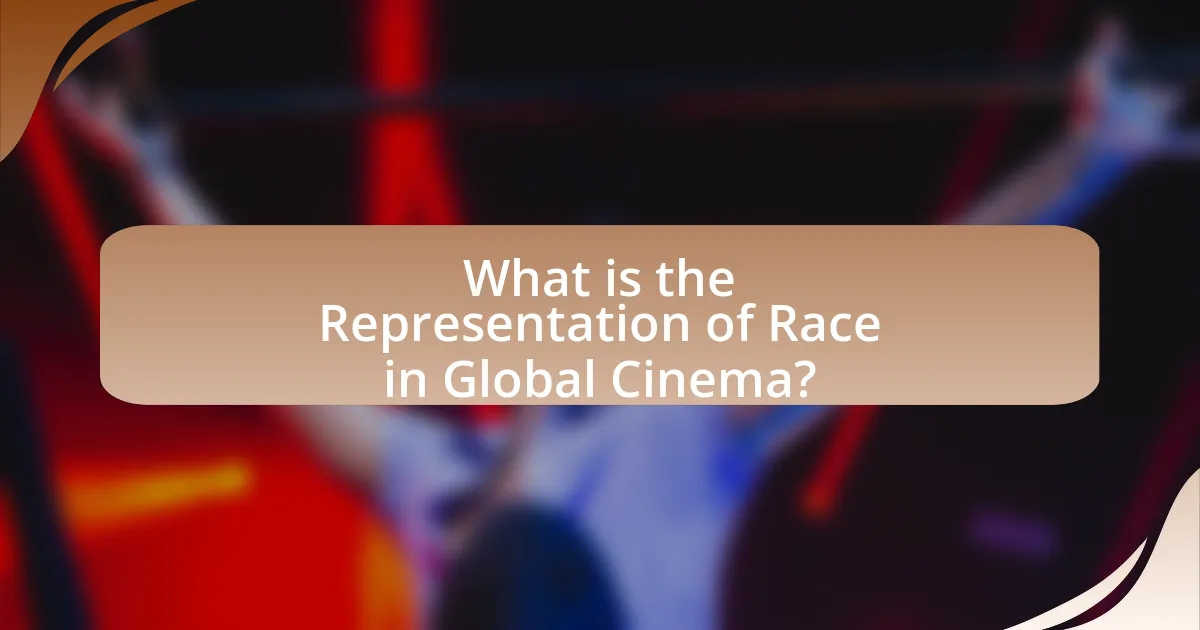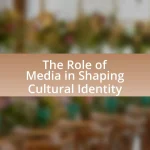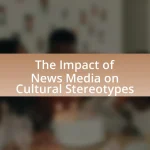The article analyzes the representation of race in global cinema, focusing on how various racial and ethnic groups are portrayed across different cultures. It examines the historical evolution of racial representation, highlighting significant societal events that have influenced cinematic narratives. The article discusses the impact of diverse storytelling and the role of filmmakers in shaping racial narratives, while also addressing the challenges faced in Hollywood and the differences in representation across non-Western cinemas. Key themes such as stereotyping, identity exploration, and intersectionality are explored, along with methodologies for analyzing race representation and the implications for societal perceptions.

What is the Representation of Race in Global Cinema?
The representation of race in global cinema refers to how different racial and ethnic groups are portrayed in films across various cultures and countries. This representation often reflects societal attitudes, stereotypes, and power dynamics, influencing public perception and cultural narratives. For instance, studies have shown that Hollywood historically underrepresents people of color, with a 2019 report from the USC Annenberg Inclusion Initiative revealing that only 29.9% of speaking characters in top-grossing films were from underrepresented racial/ethnic groups. In contrast, cinema from countries like India or Nigeria often showcases diverse narratives that challenge Western-centric views, highlighting the complexity of race and identity within their own cultural contexts. Thus, global cinema serves as a mirror to societal values and can either reinforce or challenge existing racial stereotypes.
How has the representation of race evolved in global cinema over time?
The representation of race in global cinema has evolved significantly from stereotypical portrayals to more nuanced and diverse characters. Initially, early cinema often depicted racial minorities through caricatures and negative stereotypes, reinforcing societal prejudices. For example, films from the early 20th century, such as “The Birth of a Nation” (1915), showcased overt racism and glorified the Ku Klux Klan, reflecting the racial tensions of the time.
As societal attitudes began to shift, particularly during the civil rights movements of the 1960s, filmmakers started to challenge these stereotypes. The emergence of films like “Guess Who’s Coming to Dinner” (1967) highlighted interracial relationships and aimed to promote understanding and acceptance. By the late 20th century, the representation of race became more complex, with filmmakers from diverse backgrounds telling their own stories, as seen in Spike Lee’s “Do the Right Thing” (1989), which addressed racial tensions in urban America.
In the 21st century, global cinema has continued to diversify, with increased representation of various racial and ethnic groups in leading roles and behind the camera. Films such as “Black Panther” (2018) not only showcased Black excellence but also celebrated African culture, contributing to a broader understanding of race in cinema. This evolution reflects a growing recognition of the importance of authentic representation and the impact of storytelling on societal perceptions of race.
What historical events have influenced racial representation in films?
Historical events such as the Civil Rights Movement, the abolition of slavery, and the rise of multiculturalism have significantly influenced racial representation in films. The Civil Rights Movement in the 1960s led to increased visibility and representation of African Americans in cinema, as filmmakers began to address racial issues more openly, exemplified by films like “Guess Who’s Coming to Dinner” (1967). The abolition of slavery in the 19th century shifted narratives around race, allowing for more complex portrayals of Black characters, moving away from stereotypes. Additionally, the rise of multiculturalism in the late 20th century encouraged diverse storytelling, leading to films that reflect a broader spectrum of racial identities and experiences, such as “Black Panther” (2018), which showcased African culture and representation on a global scale. These events collectively shaped the evolution of racial representation in the film industry, pushing for more authentic and varied portrayals of different racial groups.
How do different cultures portray race in their cinematic narratives?
Different cultures portray race in their cinematic narratives through unique storytelling techniques, character development, and thematic exploration that reflect their societal values and historical contexts. For instance, Hollywood often emphasizes individualism and the “American Dream,” which can lead to stereotypical representations of racial minorities, as seen in films like “Black Panther,” which showcases African culture while also addressing issues of identity and diaspora. In contrast, Bollywood films frequently incorporate race within the framework of family and community, often portraying complex relationships among diverse ethnic groups, as exemplified in “Lagaan,” which addresses colonialism and class struggles. Additionally, African cinema, such as “Tsotsi,” often focuses on the socio-political realities of race, highlighting the struggles against systemic oppression and the quest for identity. These portrayals are shaped by each culture’s historical experiences, social dynamics, and artistic traditions, leading to varied representations of race across global cinema.
Why is analyzing race representation in cinema important?
Analyzing race representation in cinema is important because it influences societal perceptions and cultural narratives. The portrayal of different racial and ethnic groups in films can shape audience attitudes, reinforce stereotypes, or promote understanding and empathy. For instance, a study by the University of Southern California’s Annenberg Inclusion Initiative found that only 28.3% of speaking characters in films from 2007 to 2019 were from underrepresented racial/ethnic groups, highlighting a significant disparity in representation. This lack of diversity can perpetuate harmful stereotypes and limit the visibility of diverse stories, making it crucial to analyze and address these representations to foster a more inclusive and accurate portrayal of society in cinema.
What impact does film representation have on societal perceptions of race?
Film representation significantly shapes societal perceptions of race by influencing stereotypes and cultural narratives. For instance, studies have shown that consistent portrayals of racial minorities in specific roles can reinforce societal biases, as seen in the historical depiction of African Americans in film as criminals or subservient characters. Research by the University of Southern California’s Annenberg Inclusion Initiative found that only 28.3% of speaking characters in films were from underrepresented racial/ethnic groups, which limits diverse narratives and perpetuates a narrow view of race. This lack of representation can lead to a skewed understanding of racial identities and experiences, ultimately affecting public attitudes and policies related to race.
How can film analysis contribute to discussions on race and identity?
Film analysis can significantly contribute to discussions on race and identity by revealing how cinematic narratives shape and reflect societal perceptions of race. Through the examination of character development, plotlines, and visual representation, film analysis uncovers the underlying ideologies that inform racial stereotypes and identity constructs. For instance, studies have shown that films like “Black Panther” and “Get Out” challenge traditional portrayals of race, offering nuanced perspectives that resonate with contemporary discussions on identity. By analyzing these films, scholars and audiences can engage in critical dialogues about the implications of representation, thereby fostering a deeper understanding of race and identity in both historical and modern contexts.
What are the key themes in the representation of race in global cinema?
Key themes in the representation of race in global cinema include stereotyping, identity exploration, and intersectionality. Stereotyping often manifests through the portrayal of racial groups in limited or negative roles, reinforcing societal biases; for example, the frequent depiction of Black characters as criminals in Hollywood films. Identity exploration allows filmmakers to delve into the complexities of race and cultural heritage, as seen in films like “Black Panther,” which celebrates African culture while addressing issues of diaspora. Intersectionality highlights how race intersects with other identities, such as gender and class, influencing characters’ experiences and narratives, as demonstrated in films like “The Farewell,” which examines the Asian-American experience. These themes reflect broader societal conversations about race and contribute to the ongoing discourse in global cinema.
How do stereotypes manifest in film portrayals of different races?
Stereotypes manifest in film portrayals of different races through the use of exaggerated traits, limited character roles, and predictable narratives that reinforce societal biases. For instance, African American characters are often depicted as criminals or athletes, while Asian characters may be portrayed as overly studious or martial artists. This pattern is evident in films such as “Breakfast at Tiffany’s,” where Mickey Rooney’s portrayal of a Japanese character exemplifies racial caricature, and “The Help,” which presents African American maids in subservient roles. Research by the University of Southern California’s Annenberg Inclusion Initiative found that only 29% of speaking characters in films are from underrepresented racial/ethnic groups, highlighting the lack of diverse representation and the perpetuation of stereotypes.
What role do filmmakers play in shaping racial narratives?
Filmmakers play a crucial role in shaping racial narratives by influencing public perception and cultural understanding of race through their storytelling choices. By selecting specific themes, characters, and narratives, filmmakers can either reinforce stereotypes or challenge them, thereby impacting societal attitudes towards different racial groups. For instance, films like “Black Panther” have been credited with promoting positive representations of Black culture and identity, while also addressing complex social issues such as systemic racism. This influence is supported by research indicating that media representation significantly affects audience attitudes and beliefs about race, as highlighted in studies by the American Psychological Association, which show that diverse and accurate portrayals can lead to greater empathy and understanding among viewers.
How does the representation of race differ across various global cinema industries?
The representation of race varies significantly across global cinema industries, influenced by cultural, historical, and socio-political contexts. For instance, Hollywood often portrays race through a lens of stereotypes, with a history of marginalizing non-white characters, as seen in films like “Breakfast at Tiffany’s,” where Mickey Rooney’s portrayal of a Japanese character exemplifies racial caricature. In contrast, Bollywood tends to emphasize colorism and caste dynamics, often favoring lighter-skinned actors, which reflects societal beauty standards in India. Additionally, African cinema frequently addresses post-colonial themes and identity, as demonstrated in films like “Timbuktu,” which critiques social issues and religious extremism in Mali. These differences highlight how each cinema industry navigates race, shaping audience perceptions and cultural narratives.
What are the unique challenges faced by filmmakers in representing race in Hollywood?
Filmmakers in Hollywood face unique challenges in representing race, primarily due to systemic biases, market pressures, and the need for authenticity. Systemic biases manifest in the predominance of white narratives and decision-makers, which limits diverse storytelling and often leads to stereotypes. Market pressures compel filmmakers to cater to mainstream audiences, which can result in diluted or misrepresented portrayals of racial identities to avoid alienating viewers. Additionally, the quest for authenticity requires filmmakers to navigate cultural nuances and avoid appropriation, making it essential to involve individuals from the represented communities in the creative process. These challenges are evidenced by the ongoing discussions around representation in films like “Black Panther,” which highlighted both the celebration of Black culture and the scrutiny of its portrayal in a predominantly white industry.
How do non-Western cinemas approach racial representation differently?
Non-Western cinemas approach racial representation by emphasizing local cultural narratives and social contexts, often prioritizing authenticity over Western-centric portrayals. For instance, Indian cinema frequently showcases the complexities of caste and regional identities, reflecting the diverse social fabric of the country, while African cinema often addresses post-colonial themes and the impact of historical injustices on contemporary society. This focus on indigenous experiences allows non-Western films to challenge stereotypes and provide nuanced perspectives that differ from the homogenized representations often found in Western media.
What methodologies can be used to analyze race representation in films?
Quantitative content analysis and qualitative analysis are two primary methodologies used to analyze race representation in films. Quantitative content analysis involves systematically coding and counting the presence of racial groups, stereotypes, and roles within a film’s narrative, allowing researchers to identify patterns and trends over time. For example, a study might analyze the percentage of screen time allocated to different racial groups across a sample of films to assess representation levels. Qualitative analysis, on the other hand, focuses on the interpretation of themes, character development, and narrative arcs related to race, often employing methods such as critical discourse analysis or semiotic analysis to explore how racial identities are constructed and perceived in cinematic contexts. Both methodologies provide valuable insights into the complexities of race representation in global cinema.
How can qualitative analysis enhance our understanding of racial themes in cinema?
Qualitative analysis enhances our understanding of racial themes in cinema by providing in-depth insights into character development, narrative structures, and cultural contexts. This method allows researchers to explore how films portray race, revealing underlying biases, stereotypes, and social commentary. For instance, studies like “Racial Representation in Film: A Qualitative Analysis” by Smith et al. (2018) demonstrate that qualitative approaches can uncover the complexities of racial identities and their representation, highlighting how these portrayals influence audience perceptions and societal attitudes. By analyzing dialogues, visual elements, and audience reactions, qualitative analysis offers a nuanced understanding of how racial themes are constructed and interpreted in cinematic narratives.
What role does audience reception play in the analysis of race in films?
Audience reception significantly influences the analysis of race in films by shaping interpretations and understandings of racial representations. The way audiences respond to racial portrayals can reveal societal attitudes, biases, and cultural contexts that inform the production and consumption of film. For instance, studies have shown that diverse audience demographics can lead to varied interpretations of the same film, highlighting how personal experiences and cultural backgrounds affect perceptions of race. Research by the University of Southern California’s Annenberg Inclusion Initiative found that films with racially diverse casts often receive different audience ratings based on the racial composition of the viewers, indicating that audience reception is a critical factor in evaluating racial representation in cinema.
What are the implications of race representation in contemporary global cinema?
Race representation in contemporary global cinema significantly influences societal perceptions and cultural narratives. Accurate and diverse portrayals can challenge stereotypes, foster empathy, and promote inclusivity, while misrepresentation can perpetuate biases and reinforce systemic inequalities. For instance, the success of films like “Black Panther” demonstrates how positive representation can lead to increased visibility and acceptance of marginalized communities, contributing to broader discussions about race and identity. Conversely, the lack of representation or negative portrayals in mainstream media can lead to harmful stereotypes, as evidenced by studies showing that media portrayals often shape public attitudes towards different racial groups. Thus, race representation in cinema plays a crucial role in shaping cultural understanding and social dynamics.
How do current films reflect or challenge historical racial stereotypes?
Current films reflect and challenge historical racial stereotypes by portraying diverse narratives and complex characters that counter traditional depictions. For instance, films like “Black Panther” and “Crazy Rich Asians” showcase protagonists from historically marginalized groups in empowered roles, thereby subverting stereotypes that often depict these groups in a negative light. Additionally, the rise of filmmakers from various racial backgrounds contributes to a broader representation of experiences, allowing for more nuanced storytelling. Research indicates that representation in media can significantly influence societal perceptions, as seen in studies by the Geena Davis Institute on Gender in Media, which highlight the impact of diverse portrayals on audience attitudes.
What trends are emerging in the representation of race in modern cinema?
Emerging trends in the representation of race in modern cinema include increased diversity in storytelling, more complex characters of color, and a shift towards authentic narratives that reflect real-life experiences. Films such as “Black Panther” and “Crazy Rich Asians” have demonstrated the commercial viability of diverse casts, leading to a broader acceptance of varied racial narratives in mainstream cinema. Additionally, there is a growing emphasis on intersectionality, where filmmakers explore how race intersects with other identities, such as gender and class, thereby enriching the narrative landscape. This trend is supported by data from the USC Annenberg Inclusion Initiative, which found that films with diverse casts tend to perform better at the box office, indicating a demand for inclusive representation.
What practical steps can filmmakers take to improve racial representation in their work?
Filmmakers can improve racial representation in their work by actively diversifying their casting, hiring practices, and storytelling perspectives. This involves intentionally seeking out actors from underrepresented racial backgrounds for roles, ensuring that the creative team, including directors, writers, and producers, reflects a variety of racial experiences. Research shows that films with diverse casts and crews tend to perform better at the box office and receive higher critical acclaim, as seen in the success of films like “Black Panther,” which featured a predominantly Black cast and was celebrated for its cultural representation. Additionally, filmmakers should engage with communities and cultural consultants to authentically portray racial narratives, thereby enhancing the accuracy and depth of their stories.
How can diverse storytelling enhance the authenticity of racial representation?
Diverse storytelling enhances the authenticity of racial representation by incorporating a wide range of perspectives and experiences that reflect the complexities of different racial identities. This approach allows for more nuanced characters and narratives that challenge stereotypes and promote understanding. For instance, research by the Annenberg Inclusion Initiative found that films with diverse writers and directors are more likely to feature authentic portrayals of underrepresented racial groups, leading to a richer and more accurate depiction of their stories. By amplifying voices from various backgrounds, diverse storytelling fosters empathy and encourages audiences to engage with the realities of racial experiences, ultimately contributing to a more inclusive cinematic landscape.
What best practices should filmmakers follow to avoid racial stereotypes?
Filmmakers should prioritize authentic representation and engage with diverse voices to avoid racial stereotypes. This involves conducting thorough research on the cultures and communities being portrayed, ensuring that narratives are informed by the experiences of individuals from those backgrounds. Collaborating with writers, consultants, and actors who have lived experiences related to the characters can enhance authenticity and depth. Additionally, filmmakers should critically assess their scripts and character arcs for potential stereotypes, seeking feedback from diverse audiences during the development process. Studies have shown that films with diverse representation not only resonate better with audiences but also contribute to a more nuanced understanding of different cultures, as evidenced by the success of films like “Black Panther,” which showcased authentic African culture and narratives.










